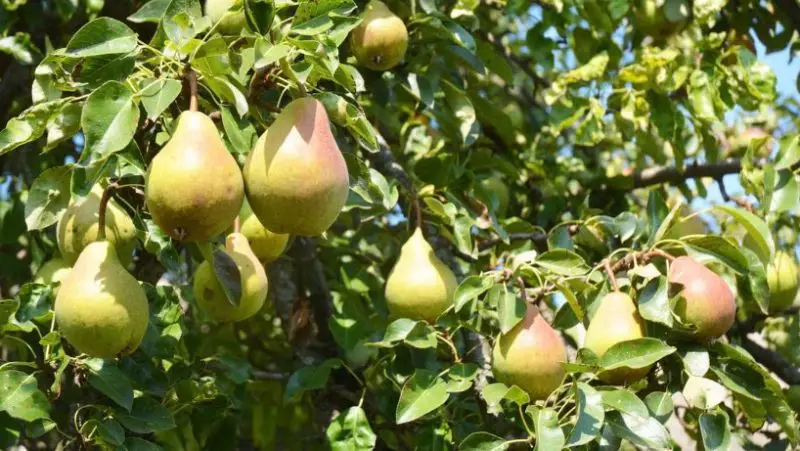Pear trees are a delightful addition to any garden. Known for their beautiful blossoms in the spring and delicious fruit in the fall, growing pears can be a rewarding experience. However, to achieve a thriving, productive pear tree, proper care and attention to the growing environment are essential.
This ultimate guide to pear tree care will help you understand the essentials of planting, maintaining, and harvesting pears, ensuring your tree flourishes for years to come.
Pear Tree Overview

- Scientific Name: Pyrus
- Family: Rosaceae
- Plant Type: Deciduous tree
- Mature Size: 15-20 feet tall and wide
- Sun Requirements: Full sun (6-8 hours daily)
- Soil Type: Well-drained, slightly acidic soil (pH 6.0-6.5)
- Watering: 1-1.5 inches per week
- Climate: Prefers temperate climates, hardy in USDA zones 4-9
- Pollination: Requires cross-pollination with a different pear variety
- Fruits: Ripen in late summer to fall
- Common Varieties: Bartlett, Bosc, Anjou, and more
- Pruning: Annual pruning to remove dead/diseased wood and shape the tree
- Pests & Diseases: Susceptible to aphids, pear coddling moth, fire blight
- Harvesting: Pears are typically harvested when firm and left to ripen off the tree
Choosing the Right Pear Tree Variety
Before planting your pear tree, it’s important to select the right variety based on your region, climate, and taste preferences. Some of the most popular types include:
- Bartlett Pears: Known for their sweet, juicy flavor, these pears are ideal for fresh eating, canning, and baking.
- Bosc Pears: These pears have a unique, firm texture and are excellent for baking.
- Anjou Pears: A smooth-skinned pear with a mildly sweet taste, perfect for fresh consumption.
Select a variety that best suits your soil type, climate, and desired use. If you live in a colder climate, look for cold-hardy pear varieties that can withstand frost.
Planting Your Pear Tree
The first step in growing a pear tree is planting it in the right location. Pears require full sun to produce high-quality fruit, so choose a spot that gets at least 6-8 hours of sunlight per day. Here’s how to plant your pear tree for optimal growth:
Soil Preparation
To ensure optimal growth, pear trees require well-draining soil that is slightly acidic, with a pH range of 6.0-6.5. Before planting, it’s crucial to test your soil’s pH and texture. If your soil is too alkaline or clay-heavy, amend it by adding organic matter, such as compost, to improve fertility and drainage.
For clay soil, incorporate sand or perlite to enhance aeration. If the pH is too high, you can lower it by adding elemental sulfur. Pears thrive in loose, fertile soil that drains well, as poor drainage can lead to root rot. Proper soil preparation will set the foundation for a healthy, thriving pear tree.
Spacing
When planting pear trees, it’s important to space them at least 15-20 feet apart. This distance allows for proper air circulation, which helps reduce the risk of diseases, such as mildew and rot, that thrive in damp, confined spaces. Additionally, this spacing gives the trees enough room for root expansion, ensuring they can access nutrients and water effectively.
Pear trees can grow quite large, with some varieties reaching up to 20 feet tall and wide, so adequate spacing is crucial for healthy growth. Planting them too close together can lead to competition for resources, stunted growth, and poor fruit production.
Planting Depth
When planting a pear tree, it is essential to ensure that the top of the root ball is level with the surrounding soil. Planting too deep can cause the tree to struggle as the roots may not get enough oxygen, leading to poor growth.
On the other hand, planting too shallow can expose the roots to air, causing them to dry out and potentially die. To avoid these issues, dig a hole that’s wide enough to accommodate the root ball without crowding it. Position the tree so that the root ball is flush with the soil level for optimal growth and establishment.
Watering
After planting your pear tree, water it thoroughly to help settle the soil around the roots and eliminate any air pockets. This will also ensure the roots are well-established in their new environment. During the first few weeks, water the tree regularly to promote healthy root growth. Afterward, continue to water it, especially during dry spells or hot weather, to keep the soil consistently moist.
However, be careful not to overwater, as pear trees don’t like waterlogged soil. Well-drained soil is crucial to prevent root rot and other water-related issues. Always ensure the soil remains moist but never soggy.
Pear Tree Care: Watering, Pruning and Fertilizing
Once your pear tree is planted, regular care is essential for healthy growth and a bountiful harvest.
Watering Needs
Pear trees require consistent watering, especially during dry periods. They need about 1-1.5 inches of water per week. The key is to keep the soil evenly moist but not waterlogged, as overwatering can lead to root rot. Use drip irrigation or a soaker hose to water the soil directly without wetting the foliage, as this can promote disease.
Fertilizing Pear Trees
Fertilizing your pear tree is crucial for healthy growth and fruit production. Apply a balanced fertilizer in early spring, just before the tree begins to grow actively. Avoid high-nitrogen fertilizers, as they can encourage excessive leaf growth at the expense of fruit production. Instead, opt for a balanced fertilizer with a ratio like 10-10-10 (nitrogen, phosphorus, and potassium) to provide all the essential nutrients.
In addition to fertilizer, consider adding organic compost to the base of your pear tree to improve soil health and moisture retention. Mulching around the base of the tree helps regulate soil temperature and reduces competition from weeds.
Pruning Pear Trees
Regular pruning is essential to maintain the shape and health of your pear tree. Proper pruning encourages good airflow and sunlight penetration, which helps prevent diseases and encourages higher fruit production.
- Early Pruning: In the early years, focus on training your tree into a strong central leader. Cut back competing branches and remove any dead or damaged wood.
- Annual Pruning: Each winter, prune your pear tree to remove any dead or diseased wood, as well as any branches that cross over each other. Thin out the canopy to allow sunlight to reach the inner branches.
- Summer Pruning: During the growing season, remove any water sprouts or suckers, which are weak, non-fruit-bearing shoots.
Controlling Pests and Diseases
Pear trees are susceptible to a variety of pests and diseases. Some common threats include:
- Aphids: These tiny insects can stunt growth and cause yellowing of leaves. Control them with insecticidal soap or Neem oil.
- Pear Coddling Moth: These pests burrow into the developing fruit. Use traps or apply organic insecticides to manage the moths.
- Fire Blight: This bacterial disease can cause wilting, blackened branches, and dead leaves. Prune infected branches and sterilize your pruning tools between cuts.
Regularly inspect your tree for signs of pest infestations or disease symptoms, and take action promptly to prevent widespread damage.
Pollination of Pear Trees
Most pear varieties require cross-pollination for optimal fruit production. This means you need at least two different pear tree varieties nearby to ensure successful pollination. For best results, choose varieties that bloom around the same time. Bees are the primary pollinators of pear trees, so ensure there is a healthy pollinator population in your garden.
Harvesting Pears
Knowing when to harvest your pears is crucial to achieving the best flavor and texture. Pears do not ripen fully on the tree, so it’s important to pick them while they are still firm and slightly underripe. Here’s how to tell when your pears are ready to harvest:
- Check the Color: As pears ripen, their color will change slightly. For example, Bartlett pears will turn from green to yellow when ripe.
- Twist and Lift: Gently twist the pear and lift it from the tree. If it detaches easily, it’s ready to be picked.
- Ripen Off the Tree: After harvesting, place pears in a cool, dark area to finish ripening. Most varieties will ripen within a few days to a week.
Common Problems and How to Avoid Them
While growing pear trees is generally straightforward, there are a few common challenges you may encounter and ways to avoid them:
- Poor Fruit Set: If your pear tree isn’t producing fruit, ensure it is getting at least 6-8 hours of direct sunlight daily. Pear trees often require cross-pollination from another variety to set fruit, so make sure you have compatible trees nearby. Lack of pollination or inadequate sunlight can result in poor fruit production.
- Stunted Growth: Over-fertilizing or poor soil drainage can lead to stunted growth. Avoid using excessive nitrogen fertilizers, as they can encourage rapid, weak growth. Instead, use a balanced fertilizer and ensure the soil is well-draining to prevent waterlogging. Always check the soil before planting to make sure it is fertile and provides good drainage.
- Leaf Drop: Excessive watering, poor air circulation, or diseases like fire blight can cause premature leaf drop. To prevent this, prune any infected or dead areas, and ensure the tree has plenty of space for air circulation. Proper watering is also essential—avoid overwatering, and always check soil moisture before watering. Regular monitoring and proper care will help prevent these issues and keep your pear tree healthy.
Conclusion: A Thriving Pear Tree
With the right care, attention to detail, and proper growing techniques, you can enjoy a healthy, productive pear tree in your garden. From choosing the best variety for your climate to managing pests and diseases, following these ultimate tips will ensure your pear tree grows strong, produces abundant fruit, and provides enjoyment for years to come.
Happy gardening!






